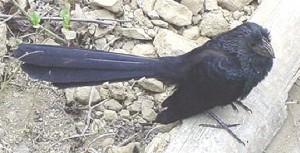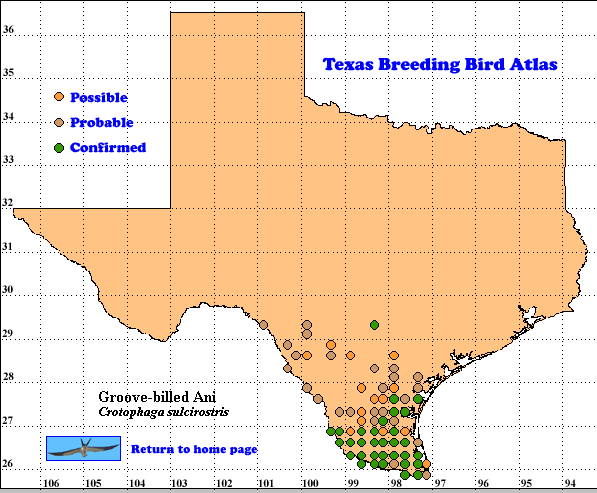The Groove-billed Ani, a long-tailed black bird, is a member of an unusual genus within an unusual family. Unlike the Old World cuckoos which often lay their eggs in the nests of other birds, these anis nest in groups of 1-5 pairs and share a common nest where all females lay their eggs and share in incubation. Some young from previous broods help feed nestlings (Bowen 2002),
Groove-billed Anis feed primarily on insects and spiders which they capture while walking, hopping or running through grassy areas or while hopping through bushes and small trees. Their diets are not limited to arthropods since they also consume fruits, berries and lizards. Members of this species communicate primarily by calls, described as squeaky, piping growling and gruff. These anis are very social, often foraging together. Pairs may remain together through multiple breeding seasons (Howell and Webb 1995, Bowen 2002).
DISTRIBUTION. During the 1987-1992 field work seasons of the TBBA project, observers found breeding evidence for the Groove-billed Ani south of the 30th parallel and west of the 97th meridian with most sites south of the 28th parallel in the South Texas Brush Country, Coastal Sand Plain and southern Coastal Prairies regions (see the region map in Lockwood and Freeman [2004]). The three highest North American Breeding Bird Survey (BBS) routes average 2.0-2.6 anis per route. These were in Brooks, Willacy and Zapata counties in these regions (Price et al. 1995).
From Texas the range of this ani continues south along both coasts of northern and central Mexico then south through Middle and South America to northern Chile and northwest Argentina (Howell and Webb 1995, Am. Ornithol. Union 1998, Bowen 2002).
SEASONAL OCCURRENCE. Groove-billed Anis are primarily summer residents in Texas, breeding from early May to mid-September, based on egg collection dates from May 16 to July 10 and young in the nest as late as September 11. Vagrants have been found across the state during this season. After the breeding season, ani numbers decrease in many of their breeding areas, remaining highest along the lower Texas coast. These movements need further study (Oberholser 1974, Lockwood and Freeman 2004).
BREEDING HABITAT. Groove-billed Anis breed in Texas from near sea level to 120m (400 ft) in thick thorn forests of Texas ebony, mesquite, acacia and mimosa (Oberholser 1974). In other parts of their extensive range these cuckoos are often found in open savannas and brushy pastures. where they build their large, bulky nests in trees such as citrus or bushes such as minosa at an average height of about 3.5 m (8 ft) above ground. usually concealed in foliage. Nests may be as low as 1 m (3 ft) in substrates such as sugar cane or as high as 13 m (43 ft) in taller trees. The shallow, bowl-shaped structure is constructed by all participating pairs. Males bring twigs, forb stems, grass tufts, torn palm leaves and rootlets. The females arrange these items crudely, leaving twigs protruding as much as 0.3 m (1 ft; Harrison 1979, Bowen 2002).
The nest, about 30 cm (12 in) outside diameter and 10-17 cm (4-7 in) is lined with fresh green leaves. More leaves are added during the incubation and nestling stages. Nests have been reported from Central America with 15 and 20 eggs but the clutch average from the Brownsville-Matamoros area is 5.4 eggs (15 nests). In single pair nests females lay an average of 4 turquoise blue eggs with a chalky white overlay. The decomposing leaves in the nests stain the eggs during incubation. Each female lays an egg every other day. Ejection of eggs in multi-pair nests has been reported. Incubation by both sexes lasts about 13 days and nestlings normally leave the nest 8-10 days after hatching when they are capable of short flights. They remain in their natal groups until the end of the breeding season, 1-6 months after they hatch. (Bowen 2002).
STATUS. Groove-billed Anis are considered common summer residents in the lower Rio Grande valley, becoming less common and local further north in the South Texas Brush Country (Lockwood and Freeman 2004). The density of reported breeding sites on the TBBA map concurs with this conclusion. The TBBA map is generally similar to the distribution of summer and breeding symbols on the map in Oberholser (1974), except TBBA field workers did not find breeding evidence in the Houston and Big Bend areas. Data from the BBS produce an annual population change, derived from 15 routes, of -17.8% for the period 1980-2006 (Sauer et al. 2007). This alarming trends needs further study.
Text by Robert C. Tweit (2008)
Literature cited.
American Ornithologists’ Union. 1998. Checklist of North American birds, 7th ed. Am, Ornithol. Union, Washington, DC.
Bowen, B. S. 2002. Groove-billed Ani (Crotophaga sulcirostris). InThe birds of North America, No. 612 (A. Poole and F. Gill, eds.). The Birds of North America, Inc., Philadelphia, PA.
Harrison, H. H. 1979. A field guide to western birds’ nests. Houghton Mifflin, Boston, MA.
Howell, S. N. G. and S. Webb. 1995. A guide to the birds of Mexico and northern Central America. Oxford University Press, New York.
Lockwood, M. W. and B. Freeman. 2004. The TOS handbook of Texas birds. Texas A&M University Press, College Station.
Oberholser, H. C. 1974. The bird life of Texas. University of Texas Press, Austin.
Price, J., S. Droege, and A. Price. 1995. The summer atlas of North American birds. Academic Press, New York.
Sauer, J. R., J. E. Hines, and J. Fallon. 2007. The North American breeding bird survey, results and analysis 1966-2006. Version 7.23.2007. USGS Patuxent Wildlife Research Center, Laurel MD < http://www.mbr-pwrc.usgs.gov/bbs>

